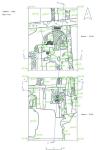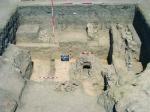Summary (English)
PLISKA (Pavel Georgiev – pavel_g@gbg.bg, Tihomir Tihov, Gergana Ilieva) The foundations of the Small Timber Fortification was 2.20 – 2.30 m wide and consisted of two parallel trenches. The outer trench accommodated a stone structure and the foundation of the palisade that consisted of posts up to 18 cm in diameter. Three occupation layers were documented on the site. The top layer contained debris from buildings, including sunken-floored ones. Building No. 1 was ramshackle and had a foundation of stones. Two hearths and several querns were discovered close to it. The finds from the building included sherds of c. AD 1000 – 1050 from pots, amphorae and glazed tableware. The occupation layer beneath Building No. 1 contained finds of the end of the 10th – beginning of the 11th centuries AD. A sunken-floored house with two ovens was discovered there. Midden Pit No. 2 was also discovered, containing a lead cross – encolpion, a piece of another lead cross – encolpion, an iron arrowhead, a fishing hook and sherds of c. AD 1050. Building No. 2 constructed of stones was partly excavated. It was partly dug into a layer containing an anonymous Byzantine follis of Class A2 (AD 976 – 1030/1035). The occupation layer of the 10th – 11th centuries AD contained fewer structures. A second early underground building was discovered. A dugout with an oven, dug deep into the bedrock was explored. The finds from the dugout included sherds from pots of c. AD 800 – 850, bones from birds, small mammals, fish and a shell of a river clam. The early underground building was constructed after AD 811 when Pliska was burned down by the Byzantine army. At least two underground buildings existed at the inner side of the western fortification wall of the Stone Fortress, each one being several dozens meters long and consisting of sunken-floored rooms with ovens or stone stoves. These buildings were probably occupied by the builders of the Stone Fortress.
- Pavel Georgiev - Shumen Branch of the Archaeological Institute and Museum
- Tihomir Tihov - Regional Museum of History – Shumen
- Gergana Ilieva - Regional Museum of History – Shumen
Director
- Gergana Ilieva - Regional Museum of History – Shumen
- Pavel Georgiev - Shumen Branch of the Archaeological Institute and Museum
- Tihomir Tihov - Regional Museum of History – Shumen
Team
Research Body
- Regional Museum of History – Shumen
- Shumen Branch of the Archaeological Institute and Museum






![Download [PDF]](/excavation/skins/fasti/images/results/download_sml.png)


